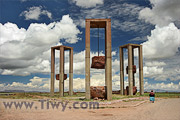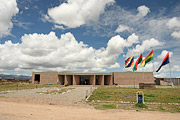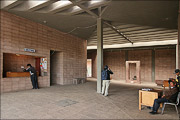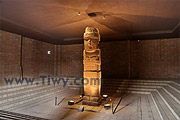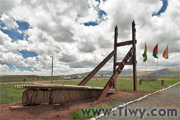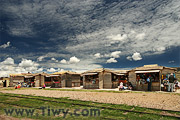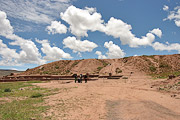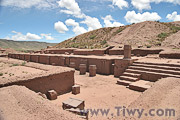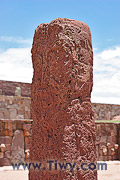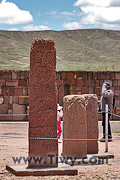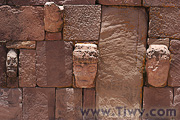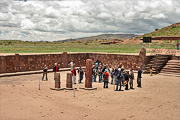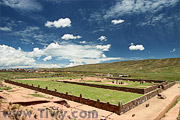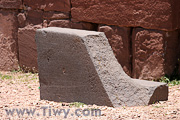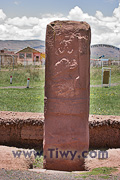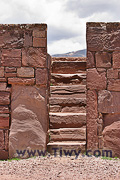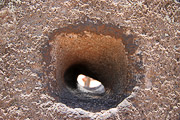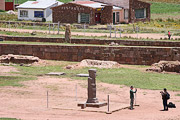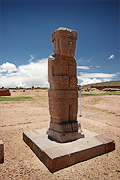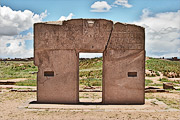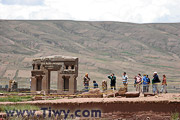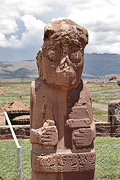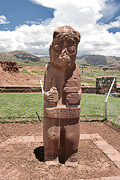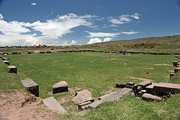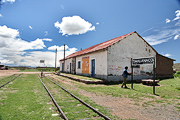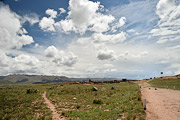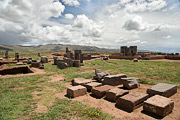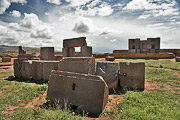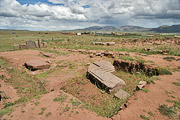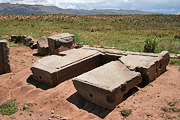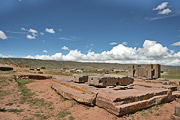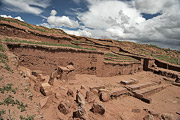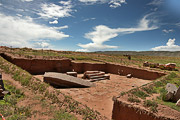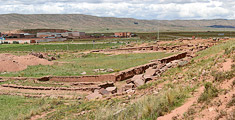Archaeological complex Tiwanaku
February 2008
Tiwanaku — are mysterious ruins on the Bolivian altiplano just in 70 km from La Paz at the height of almost 4000 m in the very center of the South America.
You can get from La Paz to Tiwanaku in only 50 minutes. There is probably not a single tourist, who would refuse from so promising a trip like this.
Monument erected in honour of the mysterious civilization Tiwanaku. It seems to remind that (Tiwanaku civilization) has possessed the secret of moving the objects to large distances. Space technology? The stones seemed to be hovering in the air.
Arthur Posnansky, who came to Bolivia at the end of the 19th century, was the first scientist - enthusiast of studying the Tiwanaku ruins. The name of this scientist is respected in Bolivia, though very little is known about him. What «national roots» were not attributed to him — and sometimes he is called an Austrian and sometimes Polish or German. Neither do hey know his occupation: either naval engineer or historian-archaeologist, and quite possible just an adventurer, a tramp. Howbeit, but it was A. Posnansky to be the first to reveal a real interest to the Tiwanaku ruins. He spent half a century to study them, published articles and books, in which he tried to expose the mystery of ancient structures. Has he succeeded? We must frankly admit — he failed to. It is sufficient to note that Posnansky has considerably made the ruins older, dating back their appearance to the 15th century B.C. The newest methods of investigation made it possible to establish that the epoch of flourishing of the Tiwanaku culture were 3 — 10 centuries A.D.
Panorama of modernised approach to the archaeological complex.

Samples of entry tickets. The price for Bolivians — 10 bolivianos, for foreign tourists — 8 times as much.
On the reverse side — is a mini diagram of Tiwanaku complex.
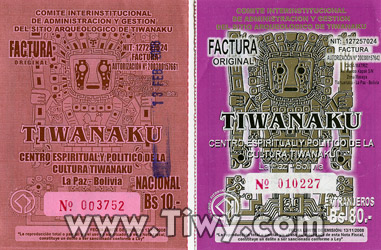
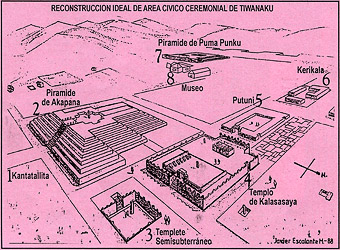
At present it is thought that creators and bearers of Tiwanaku culture (it is this pronunciation which is the closest to the original) were the forefathers of the present day Indian nation aymara — the second large population among the native people of South America.
Systematized study of the hypothetic Tiwanaku culture is actually just beginning. Scientists will have to do a lot at spacious altiplano, turn over heaps of sand, earth and stones just to get new material evidence of that distant epoch, when first rulers of the empire started to build its religious-cultural, economic and organisational base.
The Tiwanaku cultural museum nearby the complex was built in the middle of 90s of the last century. There are more than 4000 exhibits in the exposition and stores of the museum. One of the most significant is the Bennett Monolith, named so in honour of the American archaeologist that excavated it. Bolivians, however, prefer to call it Pachamama Monolith (Mother-Earth). For many years the stone idol towered above one of the squares of La Paz, enveloped by smog. Then anyone could take picture of it. Later it was moved to the built museum and as an exhibit, it was prohibited to take pictures of it. The ban, though, can be easily overcome by means of traditional for Latin America method. Can you guess which?
The Bennett Monolith. Bolivians, however, prefer to call it Pachamama Monolith (Mother-Earth).
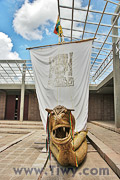
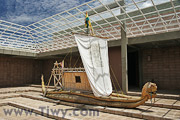
The boat made of totora can be photographed just «for free». This is clearly a decorative exhibit, as I didn't see such vessels in Titicaca lake. Thor Heyerdahl wouldn't have dared to set for a voyage on such a boat to the Easter Island, which is thought to be inhabited by active tiwanacotas.
One more recently excavated monolith. It will be placed at the entrance to the Museum under a special protective shed.
Similar to the present day Bolivians, residents of the ancient empire were not aggressive and conquered new subjects not by weapon but by authority, preaching the peaceful coexistence of tribes that are engaged in constructive labour. That is why in ancient aymara tombs they almost don't find any weapon, but in abundance they find diverse implements.
Till now there are no reliable versions about the reason of downfall of the Tiwanaku empire. One thing is evident: «empire groundwork» of the Tiwanaku rulers were further used by Incas, who in 11-16 centuries managed to create a powerful civilization on the spacious territories of the Andes.
You think about it all when you closely observe ancient stones of the archaeological complex Tiwanaku. Its present shape is unlikely thoroughly corresponding to the one that saw the eyes of the ancient aymara. This is just a reconstruction of the former greatness of the Tiwanacota civilization, that was referred by the Incas with respect and delight. One can regret that the major part of stone facing of ancient structures were later used as a construction material. And generally — it is a miracle that the general outline of the cult centre is restored and is not conceived by numerous tourists as a kind of «modern replica».
Souvenir and grocery stores in front of the entrance to the main portion of the archaeological complex Tiwanaku.
Immediately after you enter the territory of the complex you can see such a view:

The UNESCO poster says that Tiwanaku was in distant past a «spiritual and political center» of the Andes civilization. It is possible that thousands of tourists from the modern civilization that goes through a serious spiritual, ethical and moral crisis, come here in search of spirituality.
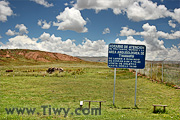
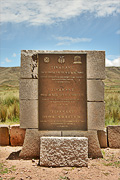
The diagram of the complex is made in such a way that the north turned out to be in the bottom, and the south — at the top.
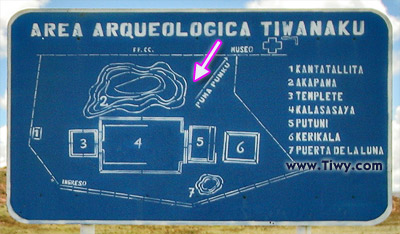
The entrance is now where the arrow is drawn.
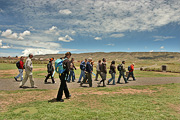
Akapana pyramid
Excavations at the foot of the Akapana pyramid are at full swing. But one will have to restore a lot, using in particular construction stone from the same stone quarry that were also used by ancient aymara.
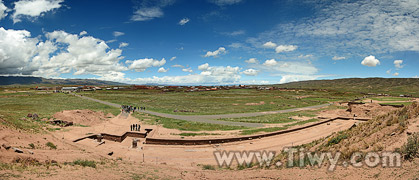
At the top: View from the Akapana pyramid to the western area of excavations.
At the bottom: View from Akapana to the area of restoration works at the Templo de Kalassasaya.


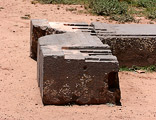
View to the village Tiwanaku:

Now, we'll descend from the pyramid Akapana and will go to the Templo Semisubterraneo (at the right)..

Templo Semisubterraneo (Semisubterranean temple)
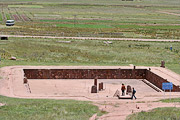
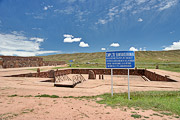 .
.

Scientists assume that religious ceremonies of remembrance of the dead were held in Templo Semisubterraneo (Semisubterranean temple). The temple represented a sui generis «subterranean world», where souls of aymara ancestors used to live, as well as the souls of those aymara who were yet to be born. They write a lot and contradictory things about the three monoliths that tower on the territory of this temple. Who do they represent? Gods? Chiefs? Celestial aliens? That is why it is not worth to add new interpretations.
According to scientists, stone faces built in the inner walls, testify, that the Tiwanaku civilization included many tribes and nations of altiplano and adjacent to it areas. These conclusions are made on the basis that stone faces radically differ one from another.
Those tourists, who reached this place during excursions bareheaded, tomorrow will suffer from sunburns of faces and will be very sorry that did not get hats in advance.
I say this because I know very well what awaits them...
Kalasasaya
Sector Kalasasaya was created, as is thought, in contrast to the subterranean kingdom. Kalasasaya is a window on the Earth that is opened to the sky. From here, the priests, «dedicated to mysteries of the universe» communicated with gods. «Sovereign gates» of the Tiwanacota empire were located here. As Puerta del Sol (Gates of the Sun) they are often represented as the symbol of Bolivia.

The past of the Tiwanaku civilization can be read in carving and pictures on the Puerta del Sol / Puerta de la Luna (Gates of the Sun/Gates of the Moon), in human images, built in the walls of Templete Semisubterraneo (Semisubterranean temple), in motionless figures of nameless rulers. Unique is also a «megaphone ear» that enabled priests of the Tiwanaku past bring to the notice of those masses important messages or listen to the talks of careless subjects. So the first stone microphone was evidently invented in Tiwanaku.
Templo de Kalasasaya with its stone steps and main entrance has become a witness not only of the distant past, but also of astonishing by its significance newest history: it is through this ancient entrance that the presently ruling Evo Morales, first Indian leader of the country for the last 500 years, passed and then addressed the nation. Inauguration of this descendant of ancient aymara was held on January 21, 2006, and became a symbolic ceremony of return to the background of statehood, testified that the previously silent Indian «mass» (about 60% of the population) was awaken from century-long passiveness.
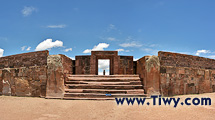
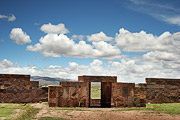
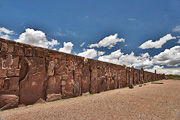
Magnetic stone — another mystery of Kalasasaya. How did it appear here?
It is better not to pass here with diskettes, photobanks and tickets to subway.
Monolith at one of the entrances to the Tiwanaku complex.
Side stairway-entrance to Kalasasaya.
Opening in the stone block that, as supposed, was used as a hearing aid and/or megaphone.
Ponce Monolith got its name after the Bolivian discoverer, anthropologist Carlos Ponce. As a rule, the scientific works describe the outward appearance of the monolith and make guesses about its purpose.
Puerta del Sol (Gates of the Sun) is the most replicated «image» of Bolivia. Residents of the village once tried to shift the gates to the main square (clearly pursuing the commercial purpose) but they were not allowed: Gates of the Sun belong to all Bolivians!
El Fraile Monolith («Monk») is called rather randomly. They write that it depicts the «head of the state». Well, leaders of Tiwanaku evidently had problems with charisma.
Putuni
Sector Putuni is still in ruins. I could not find any versions about its destination. Apparently they haven't thought it up yet.
Puerta de la Luna (Gates of the Moon)
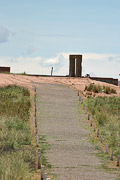
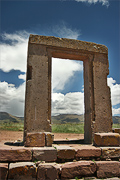
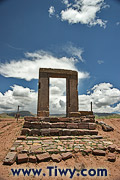
Puerta de la Luna (Gates of the Moon). The name is also quite random, chosen to «balance» the Puerta del Sol (Gates of the Sun) and add to the tourist route more aesthetic essence.
Last portion of the complex is called Puma Punku and is situated in few minutes drive from here.
Railway station Tiahuanaco, 3820 meters above the sea level.
Puma Punku
In the close vicinity from Tiwanaku there is another cult center - Puma Punku, that arouses more questions then answers with scientists. And the most important question — what was its «hierarchical» relation to Tiwanaku? Subjection? Competitive? Independent?
According to huge stone blocks of the former Pyramid temple Puma Punku one can easily guess that its highest servicemen possessed immense power and «mobilisation potential» of manpower. Otherwise how could one arrange sculpturing of these blocks that weigh 30-130 tons (!!!) and shifting them from stone quarries to the distance of 10-12 kilometers. Often they draw a parallel of these figures and moai at the Easter Island.
Nowadays in Puma Punku they carry out archaeological-restoration works that need considerable financial investments. The Evo Morales government does spare expenses — glorious past of the ancient Indian civilization should not remain in oblivion.
Stone blocks are removed from the ground, then selected one to another (as if in Rubik's cube) return to its original composition. At our times only engineers and builders can evaluate the quality of work with stone of ancient Tiwanacotas. It is due to this reason I put a selection of photos from Puma Punku. It is interesting to hear the opinion of professionals.



